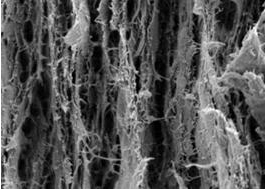Home > Press > “Super paper:” New nanopaper more break-resistant than cast iron
 |
| Scientists report development of cellulose nanopaper, a superstrong material that could be used in the construction industry. Above is a cross-section of a fracture surface of a cellulose nanofibril film. Courtesy of American Chemical Society |
Abstract:
Researchers in Sweden and Japan report development of a new type of paper that resists breaking when pulled almost as well as cast iron. The new material, called "cellulose nanopaper," is made of sub-microscopic particles of cellulose and may open the way for expanded use of paper as a construction material and in other applications, they suggest. Their study is scheduled for the June 9 issue of ACS' Biomacromolecules, a monthly journal.
“Super paper:” New nanopaper more break-resistant than cast iron
Stockholm, Sweden | Posted on June 4th, 2008In the new study, Lars A. Berglund and colleagues note that cellulose — a tough, widely available substance obtained from plants — has potential as a strong, lightweight ingredient in composites and other materials in a wide range of products. Although cellulose-based composites have high strength, existing materials are brittle and snap easily when pulled.
The study described a solution to this problem. It involves exposing wood pulp to certain chemicals to produce cellulose nanopaper. Their study found that its tensile strength — a material's ability to resist pull before snapping — exceeded that of cast iron. They also were able to adjust the paper's strength by changing its internal structure. — MTS
####
For more information, please click here
Contacts:
Lars A. Berglund, Ph.D.
Royal Institute of Technology
Stockholm, Sweden
Phone: 46-8-7908118
Fax: 46-8-7908101
Issuers of news releases, not 7th Wave, Inc. or Nanotechnology Now, are solely responsible for the accuracy of the content.
| Related News Press |
News and information
![]() Researchers develop molecular qubits that communicate at telecom frequencies October 3rd, 2025
Researchers develop molecular qubits that communicate at telecom frequencies October 3rd, 2025
![]() Next-generation quantum communication October 3rd, 2025
Next-generation quantum communication October 3rd, 2025
![]() "Nanoreactor" cage uses visible light for catalytic and ultra-selective cross-cycloadditions October 3rd, 2025
"Nanoreactor" cage uses visible light for catalytic and ultra-selective cross-cycloadditions October 3rd, 2025
Discoveries
![]() Researchers develop molecular qubits that communicate at telecom frequencies October 3rd, 2025
Researchers develop molecular qubits that communicate at telecom frequencies October 3rd, 2025
![]() Next-generation quantum communication October 3rd, 2025
Next-generation quantum communication October 3rd, 2025
![]() "Nanoreactor" cage uses visible light for catalytic and ultra-selective cross-cycloadditions October 3rd, 2025
"Nanoreactor" cage uses visible light for catalytic and ultra-selective cross-cycloadditions October 3rd, 2025
Announcements
![]() Rice membrane extracts lithium from brines with greater speed, less waste October 3rd, 2025
Rice membrane extracts lithium from brines with greater speed, less waste October 3rd, 2025
![]() Researchers develop molecular qubits that communicate at telecom frequencies October 3rd, 2025
Researchers develop molecular qubits that communicate at telecom frequencies October 3rd, 2025
![]() Next-generation quantum communication October 3rd, 2025
Next-generation quantum communication October 3rd, 2025
![]() "Nanoreactor" cage uses visible light for catalytic and ultra-selective cross-cycloadditions October 3rd, 2025
"Nanoreactor" cage uses visible light for catalytic and ultra-selective cross-cycloadditions October 3rd, 2025
Construction
![]() Temperature-sensing building material changes color to save energy January 27th, 2023
Temperature-sensing building material changes color to save energy January 27th, 2023
![]() Strain-sensing smart skin ready to deploy: Nanotube-embedded coating detects threats from wear and tear in large structures July 15th, 2022
Strain-sensing smart skin ready to deploy: Nanotube-embedded coating detects threats from wear and tear in large structures July 15th, 2022
![]() A sunlight-driven “self-healing” anti-corrosion coating May 27th, 2022
A sunlight-driven “self-healing” anti-corrosion coating May 27th, 2022
![]() Polymer fibers with graphene nanotubes make it possible to heat hard-to-reach, complex-shaped items February 11th, 2022
Polymer fibers with graphene nanotubes make it possible to heat hard-to-reach, complex-shaped items February 11th, 2022
|
|
||
|
|
||
| The latest news from around the world, FREE | ||
|
|
||
|
|
||
| Premium Products | ||
|
|
||
|
Only the news you want to read!
Learn More |
||
|
|
||
|
Full-service, expert consulting
Learn More |
||
|
|
||








